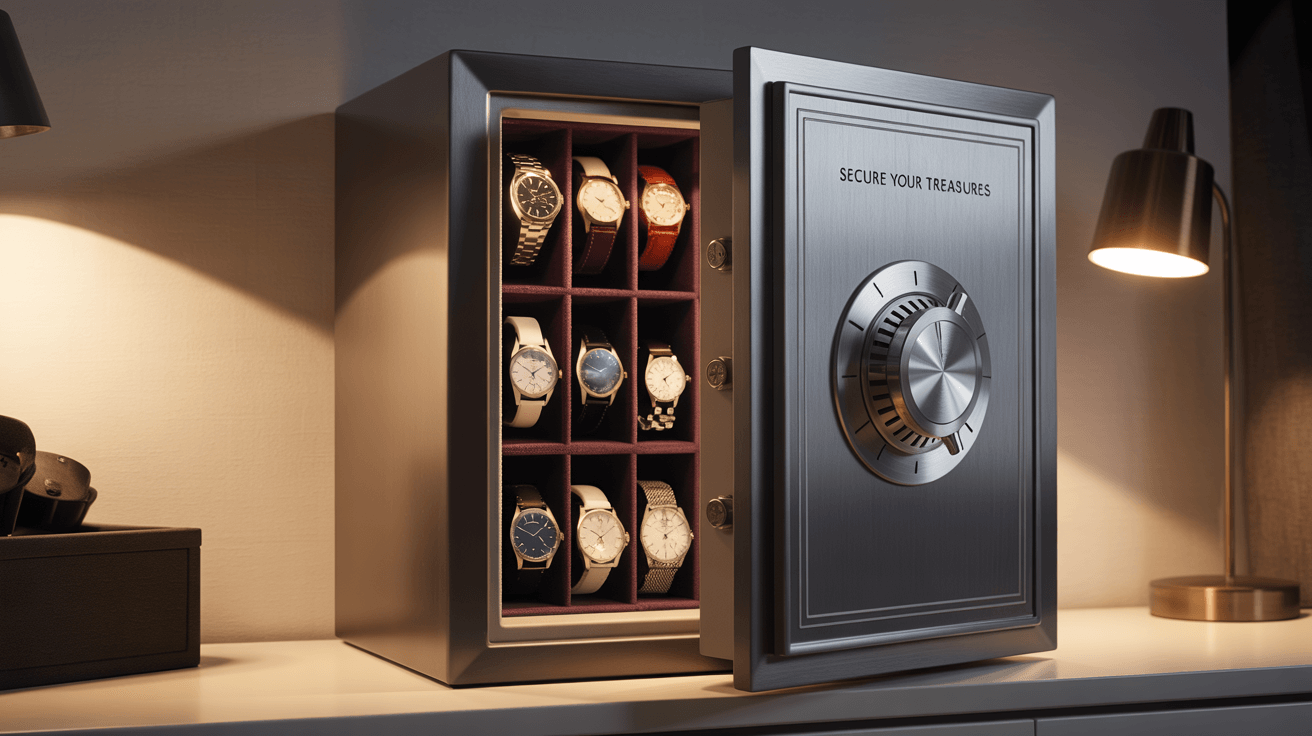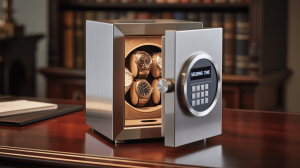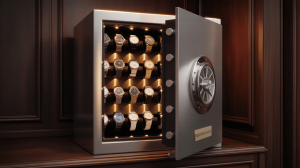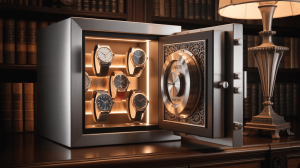How to Choose the Perfect Watch and Jewelry Safe for Your Collection. But here’s the kicker… Selecting a safe that protects both watches and jewelry requires balancing security, organization, and style to suit your unique collection.
1. Assess Your Collection Size and Growth Potential
Begin by cataloging your watches and jewelry pieces—bracelets, rings, necklaces. Estimate current space needs and add 20–30% for future acquisitions. Consider display versus storage: do you want visible shelves or hidden drawers? Proper sizing prevents overcrowding and ensures long-term flexibility.
| Safe Size Category | Capacity Range | Future Growth |
|---|---|---|
| Compact | 1–4 watches + small jewelry | Up to 6 total items |
| Mid-Size | 5–10 watches + 3–5 jewelry | Up to 15 total items |
| Large | 10+ watches + 10+ jewelry | Unlimited modular expansion |
2. Establish Your Security Requirements
Determine burglary and fire risks in your area. UL RSC or ETL burglary ratings confirm forced-entry resistance; UL 72 Class 350 fire ratings (30–60 min at 1,200 °F) protect delicate mechanisms and gemstones. Choose mechanical dials for power-free reliability, electronic keypads for multiple user codes, or biometric scanners for rapid access. Dual-lock systems combine methods for layered protection.
3. Select the Right Locking Mechanism
Mechanical combination locks never fail for lack of batteries but rotate slowly. Electronic keypads allow timed delays and audit logs of entries. Biometric fingerprint scanners unlock in seconds yet need occasional re-enrollment. Backup override keys ensure access if electronics glitch. Match your daily routine with the lock you’ll use most.
4. Optimize Interior Organization for Both Watches and Jewelry
Modular trays and foam inserts let you allocate specific bays for watches, jewelry drawers, and tool compartments. Velvet-lined watch pillows protect case finishes; ring rolls and necklace hooks keep jewelry untangled. Removable winder modules convert slots for automatics only when needed.
| Organizer Component | Purpose | Benefit |
|---|---|---|
| Watch Pillows | Cradle watches securely | Prevents movement and scratches |
| Jewelry Trays | Separate rings/earrings | Avoids tangling |
| Removable Winder Bays | Automatic watch winding | Converts as collection rotates |
5. Incorporate Watch Winder Modules
Automatic watches need motion. Choose winders with adjustable turns-per-day (TPD) settings (650–2,000), directional options (CW, CCW, bi-directional), and quiet motors (< 25 dB). Pause intervals prevent over-winding. Place winders at eye level for display; static storage slots beneath.
6. Evaluate Climate and Humidity Control Features
Humidity and dust harm movements and gemstones. Seek safes with IP54-rated door seals, built-in desiccant chambers, or active dehumidifiers. Digital hygrometers display real-time humidity, ensuring levels stay between 40–50% RH for leather straps and precious metals.
7. Balance Aesthetic Finishes with Décor
Your safe should blend or stand out as desired. Powder-coat matte black or gunmetal suits modern spaces; walnut or mahogany veneers fit classic interiors; leather wraps add boutique luxury. Glass or tinted acrylic viewing panels showcase pieces without compromising security.
| Finish Option | Style Impression | Durability |
|---|---|---|
| Matte Black Steel | Modern minimalist | Scratch and fingerprint resistant |
| Walnut Veneer | Warm traditional | Requires gentle maintenance |
| Leather Wrap | Rich luxury | Stain and wear resistant |
8. Ensure Adequate Lighting for Display
Integrated LED strips or fiber-optic spotlights illuminate watches and jewelry without heat. Warm white enhances gold and leather tones; cool white highlights stainless steel and diamonds. Motion sensors or door-activated switches conserve power.
9. Prioritize Noise and Vibration Control
Winders and locks can generate noise. Rubber-damped motor mounts and precision bearings keep sound under 25 dB. Soft-close hinges eliminate slams. Test decibel ratings and customer reviews to ensure whisper-quiet operation in bedrooms or offices.
10. Verify Power Supply and Backup Options
Electronic locks and winders need reliable energy. Look for safes supporting both AC adapters and rechargeable battery packs with low-battery alerts. USB-C or solar trickle chargers add convenience. Always keep a hidden mechanical override key for emergencies.
| Power Option | Backup Method | Maintenance |
|---|---|---|
| AC Adapter | — | Annual check |
| Rechargeable Battery | Manual override key | Recharge every 6–12 months |
| USB-C Charging | Hidden override PIN | Inspect cable quarterly |
11. Planning for Installation and Anchoring
Confirm floor or wall surfaces can bear safe weight plus contents. Bolt to studs or concrete using heavy-duty anchors per manufacturer specs. Level the safe before tightening to prevent door binding. Conceal anchor points under interior trays or carpet for a seamless look.
12. Integrate Smart Connectivity
Bluetooth or Wi-Fi safes send tamper, door-open, and humidity alerts to your smartphone. Apps allow remote lock/unlock, TPD adjustments, and audit-log reviews—craning your collection under digital watch for ultimate peace of mind.
| Connectivity Feature | Functionality | Benefit |
|---|---|---|
| Tamper Alerts | Instant notifications | Immediate awareness |
| Remote Control | App-based operations | Convenience on the go |
| Audit Logs | Access history | Traceable entry records |
13. Compare Warranty and Customer Support
A robust warranty reflects confidence—seek 2–5 year coverage on structure and electronics. Onsite service options, spare-part availability, and responsive support reduce downtime. Read user feedback on claim processes and repair quality before committing.
14. Budgeting and Value Prioritization
Safes range from $200–$300 for basic models to $800+ for hybrids with winders, connectivity, and luxury finishes. Prioritize must-have certifications and interior features; optional extras like exotic veneers or cloud monitoring can follow once core needs are met.
15. Final Selection Checklist
Compile your criteria—capacity, security ratings, lock type, organization, winders, climate control, aesthetics, lighting, power, installation, smart features, warranty, and budget—into a comparison chart. Score top models against each factor to choose the perfect vault that protects and showcases your valuable watches and jewelry.
Conclusion
Choosing the perfect watch and jewelry safe blends security, functionality, and design. Ready for the good part? Use this ultimate guide to compare features, verify certifications, and invest in a safe that safeguards and highlights your collection with lasting style.
FAQ
Q1: Do all watch safes include jewelry drawers?
Not all—verify modular interior options before purchase.
Q2: How often replace desiccant modules?
Every 6–12 months depending on humidity levels.
Q3: Can I retrofit my existing safe with winder modules?
Some manufacturers offer aftermarket winder inserts—confirm compatibility.
Q4: Are smart safes secure from hacking?
Use encrypted connections and strong unique passwords for best protection.
Q5: What maintenance keeps my safe performing?
Monthly dusting, quarterly lock tests, annual battery and desiccant replacement.







